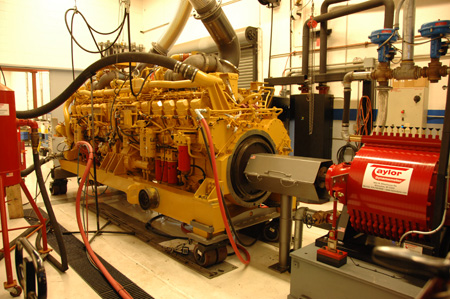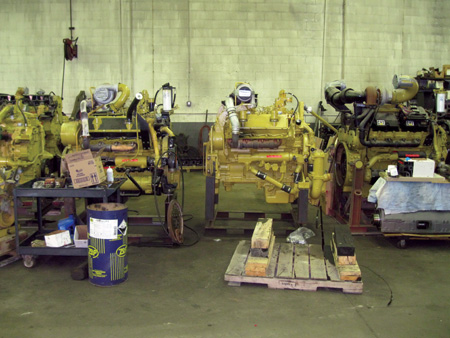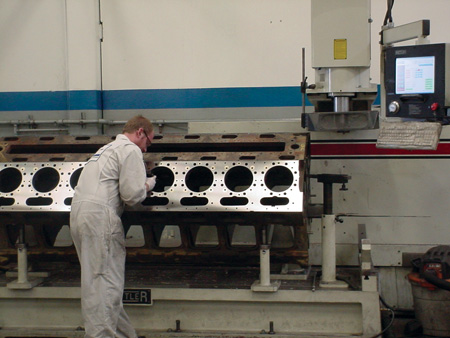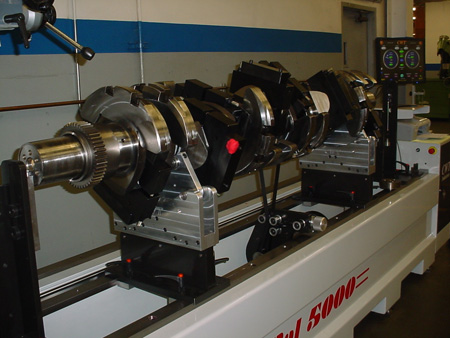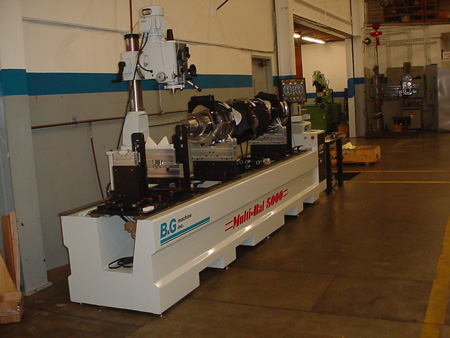One of the most sought-after status symbols in America is a pickup truck with a Cummins, Duramax or Powerstroke engine. The expectation continues that diesel automotive engines will soon find their way in larger numbers to our shores. A rebounding economy should help get trucks moving again and recapture some lost maintenance dollars.
First, what constitutes the heavy-duty diesel market? According to the U.S. Department of Transportation’s Vehicle Inventory and Use Survey (VIUS), Class 6 trucks (which may include small construction vehicles such as dump trucks or box trucks) may be classified as “light-heavy.” Traditionally, however, Class 7 vehicles (with gross vehicle weight ratings ranging from 26,001-33,000 lbs) and Class 8 vehicles (with GVWR over 33,000 lbs.) are considered the “wheelhouse” of the heavy duty market. Increasingly, this market needs to be expanded, say players in the industry.
According to part 1 of the 2010 Machine Shop Market Profile, the volume of diesel engine building, while remaining relatively strong historically, has fallen slightly over the past few years. Obvious factors such as the recession have taken their toll on the industry in general, but are there still opportunities out there for heavy-duty diesel rebuilding and engine service? The quick answer is absolutely. The more in-depth answer? You’re going to have to work at it.
“We are beginning to see shops offer both mid-range diesel and passenger car work,” says David Bianchi, vice president, sales and marketing, B&G Machine, Seattle, WA. “A great example of this is Precision Automotive Diesel in Rockford, IL. I have visited on a number of occasions with owner, Mike Eighmy, about his mix of work. He represents an increasing number of shops that offer both industrial and automotive engines. I encourage automotive shops to look at these opportunities and diversify into some of these new markets. It is very healthy for our industry.”
Bianchi says one of this industry’s biggest challenges has been in marketing the product and differentiating. “As an independent, it is important to identify the things that we can do that will make the engines more reliable. Today, we are competing with OEM-backed exchange programs and a stronger network of distribution. Selling the differences requires an in-depth, hands-on approach to customers who need improved reliability.”
Bryan Menke, R&R?Engine and Machine in Akron, OH, says “We’re currently doing a ton of in-frame rebuilds – that’s what’s keeping our garage full. Right now, our prime market seems to be the Detroit 60-series, a big engine to be overhauling. We’re also seeing a good number of DT466E engines. The drive-in business is phenomenal. We’re so backlogged back there and trying to find another one or two good mechanics has been a very difficult three-week process so far.”
Bob McDonald, Engine Builder’s Diesel Dialogue columnist reminds shops that, although they can be very profitable, bigger engines have bigger requirements.
“Some in-frame rebuilds on fleet vehicles can take approximately 40 hrs. Generally, an in-frame consists of main and rod bearings, pistons, rings, liners, recondition the cylinder head and of course new gaskets. This recondition will cost in the neighborhood of $10,000-$12,000, which may seem a very costly rebuild, but remember: this should last from 800,000 to 1 million miles,” McDonald explains.
The good news? Most automotive shops can perform service on full size diesel pick-ups and minor repair on fleet size trucks with just the equipment they already have. Get much beyond the light- to medium-duty engines, however, and you’ll face some additional requirements.
“Heavy-duty trucks require a variety of special tools just as an automotive shop requires them – the big difference is that the heavy duty shop will need a lot bigger tools. This comes from the parts being so heavy. These tools also generally come with a much greater price. These tools may include a hoist, brake tools, wrenches and sockets (generally sizes from 1-1/2? to 4?), drain pans, transmission jacks and lifts,” says McDonald.
“If I were to pick one piece of equipment that a smaller shop could use to turn a profit in the heavy-duty industry, I would say a crank grinder would be it,” says Brad Hartmann, Hartmann Bros., Inc., Abilene, TX. “A crank grinder with an experienced operator can turn out a lot of work with good profits.”
The key word, however, is experienced. “Training is another issue,” Hartmann says, “because in today’s world there just aren’t many younger people wanting to do this kind of work. When you do find some one you can tie up weeks and months training them on a certain machine or procedure on how your shop does certain machining.”
Menke and Bianchi both agree that the machinery needs can’t be overlooked, because the sheer size of diesel engines requires more robust equipment. “You can’t just lift a head up by hand and put it on the machine to do a valve job,” says Menke.
“Depending on how ambitious the shop is, the equipment might need to be larger … diesel blocks often require heavier counterboring to precision depths, for example,” says Bianchi. However, he echoes Hartmann’s call for training. “I strongly recommend proper and specific training. Start off with a long block program and work into engines. Team up with a parts supplier and offer something different. The OEMs can help with training. Another option is to pay an experienced assembler to build your engines. In doing so, make sure that he has the credentials that match the quality of your product.”
Menke says equipment needs aside, automotive engine builders can do the work. “From a skill and ability standpoint, there’s nothing stopping an automotive engine builder from getting into heavy-duty diesel,” he explains. “The ability is there, they just need training.”
McDonald says it’s easier for shops to stick with what they know, even as they’re looking to expand into additional markets. “Always learn new things, but concentrate at what you’re good at and enjoy. If you like working on Detroit Diesel then be the best Detroit man in town. You have to have a niche which sets you above the rest.”
Finding Your Customers
“Today, we service primarily industrial markets,” says Bianchi. “These include mining, marine, stationary power, oil and gas. Each of these markets represent similar margins primarily due to the high level of demand. These are quality-driven markets where engine reliability takes precedence over price. We look to where our services and the demands in the field complement each other.”
Bianchi says his company tends to stay away from on-highway work due to the current economic downturn and high volume, as well as price sensitivity. Menke understands this only too well.
“We do have a lot of owner/operators, schools, and even a small fleet or two as customers,” he says. “However, we lost a lot of our business to leasing companies. We used to do all of the local grocery chain’s trucks, but like a lot of companies, they’re leasing their trucks now.”
Because leasing programs allow customers to drive new trucks until they basically need to be replaced, Menke has seen a lot of business disappear.
“Just when a fleet is ready and primed to be overhauled, it seems like they sell their trucks and lease. Same with the local Metro bus agency. Just when you think you’re going to get a bus to overhaul they tell us ‘Ah, forget it, we’ll sell it and buy a new one with government grant money.’ That has hurt us a little bit – but to be honest, there’s plenty of work out there and there’s nothing to get upset about.”
This positive attitude is key, say all of our experts, because believe it or not there is still work out there. You may need to look beyond your traditional markets, however.
“We go after work on the oil field side for diesel electrics, such as the big Cat engines, Detroit and Cummins,” Hartmann says. “All of these have been more profitable than the diesel truck side. It is also the most challenging because of what customers ask for with the turn around time with these types of engines. Since they are sent out on to drilling rigs, time is definitely money.”
Located near Lake Erie, Menke says the marine market has also been good business. So too has been industrial and farm field work.
“We just got another drive out service truck with a crane on it. Because we are an original equipment supplier of more than 20 engine makes, we have the scanners for all the engines. We can jump in the truck, get out to the field and diagnose the problem.”
Menke says this market is very competitive, but the scanners give his shop a distinct edge. “We used to be able to use aftermarket scan tools, but you can’t really do that anymore. It’s a much greater investment, but when you’re down to the nitty gritty of what’s going on in the computer, you have to have their program.”
Menke says success in this industry means knowing your boundaries – but also knowing when to go beyond them. “We have about a 100 mile radius for field work. Much more than that we’ll usually turn it over to another dealer. Especially once you figure the mileage to get out there. However, the engine market is wide open. If it’s out there and you want it, go get it. And anymore, the way the economy is, if you want more work you absolutely have to just go out and get it.”
Some potential customers are making it difficult, however, says Menke. Increasingly, he’s seeing some fleets take maintenance less seriously to save money.
“Fleets are driving trucks longer without some regular maintenance to save costs. If they can get another month out of it, they save that money,” he says. “Sometimes it pays off – sometimes it ends catastrophically.”
And sometimes, the challenge isn’t in getting the work; it’s getting the money. Getting paid by the owner/operator can be tough,” Menke says. We have piles of completed work out there in the shop. We call them every week to remind them it’s done. They keep telling us they’ll be in, but we have to keep on them.”
Now, R&R, Engine Builder magazine’s 2006 Machine Shop of the Year, has resorted to collecting a 50 percent deposit for an engine overhaul.
“When you have a $15,000 engine with the parts you already paid for and the labor you paid for weeks ago, you’re kind of stretched out,” Menke explains. “Some of those big Cats back there are $60,000-$80,000 each. They’re done, waiting to be picked up. You either need a massive cash flow or get money up front. That way we know the customer is serious and will come back for the engine.”
“Engine builders have much to offer in this changing industry,” says David Bianchi. “We build engines whose components are made to run longer. We give the end user options. This competition is healthy for the industry and heightens the level of service for the end user. Regionally, our engines are often serviced and maintained by ex-CAT field service technicians. In addition to providing a superior engine, we also team up with premier technicians who offer better diagnostics and knowledge of the engines.”
Look for what works for you, says Bianchi. “We often compete at the dealer level. This is a lower volume, specific application engine when compared to the on highway engines. Oftentimes, there is not a national exchange program that we are competing against. At the local level, we are competing with our assembly ability, our machine shop, and a strong assortment of parts suppliers. The OEM does not have the machine shop, nor can he use this assortment of parts. This makes the OEM more susceptible to warranty issues and price. His options are limited compared to ours.”
Bob McDonald encourages builders to play to their strengths. “In today’s economy it may be your best bet to stick with what you know, even as you’re looking to expand into niche markets that interest you. Always learn new things, but concentrate at what you’re good at and enjoy. If you like working on Detroit Diesel then be the best Detroit man in town. You have to have a niche which sets you above the rest.”